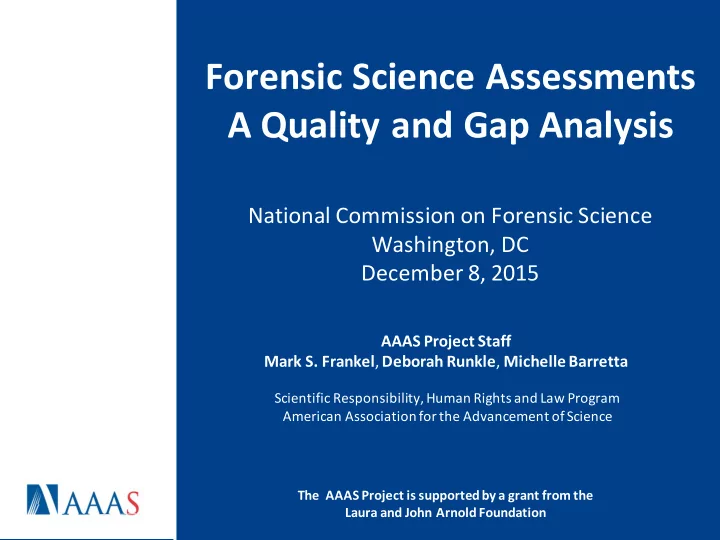

Forensic Science Assessments A Quality and Gap Analysis National Commission on Forensic Science Washington, DC December 8, 2015 AAAS Project Staff Mark S. Frankel , Deborah Runkle , Michelle Barretta Scientific Responsibility, Human Rights and Law Program American Association for the Advancement of Science The AAAS Project is supported by a grant from the Laura and John Arnold Foundation
Forensic Science Assessments: A Quality and Gap Analysis Project Advisory Committee 2
Forensic Science Assessments: A Quality and Gap Analysis Project Forensic Science Fields Fire Investigation Latent Fingerprint Analysis Firearms and Tool Marks Bitemark Analysis Trace Evidence — Hair Analysis Bloodstain Pattern Analysis Footwear and Tire Tracks Digital Evidence Trace Evidence- Fibers Trace Evidence- Paint and other coatings 3
Forensic Science Assessments: A Quality and Gap Analysis Project Lineage 2006 Congressional Appropriation The National Academies- National Research Council The White House Office of Science and Technology Policy (OSTP) National Science and Technology Council Committee on Science Subcommittee on Forensic Science (SoFS) Research, Development, Testing and Evaluation (RDT&E) American Association for the Advancement of Science (AAAS) 4
Forensic Science Assessments: A Quality and Gap Analysis Project Overview Project will evaluate the scientific foundation the forensic community relies on to support their practices and, where the scientific underpinning of these practices falls short, recommend areas requiring further study This “gap analysis” will produce a research agenda to: Serve as the basis for arriving at forensic methods that will inspire greater confidence in our criminal justice system Encourage basic scientists outside the forensic community to pursue the research topics presented in the reports and funding agencies to support these scientists Audience: Scientists (both forensic and non-forensic), legislators, legal and law enforcement communities, and public 5
Forensic Science Assessments: A Quality and Gap Analysis Planned Process for Preparing and Disseminating Reports Each working group will produce a report setting forth its findings and recommendations AAAS has commissioned a writer to produce a “plain English,” jargon -free version of each report The technical report and the more accessible version will be accompanied by a AAAS press release highlighting its findings and recommendations Each report will be posted on the AAAS website along with a PowerPoint presentation that highlights key points AAAS will host webinars associated with the release of each individual report, accessible to all stakeholders AAAS will convene briefings for Members of Congress and their staff when project is completed 6
Forensic Science Assessments: A Quality and Gap Analysis Phase 1 Working Groups 7
Forensic Science Assessments: A Quality and Gap Analysis Working Group Meetings Latent Fingerprint Analysis (Meeting: July 9, 2015) Prior to the in-person meeting, the Working Group Chair suggested that the quality of the Working Group’s review of the literature might be enhanced if they were allowed to: Frame the relevant questions themselves Make a global assessment of how well those questions were addressed by the existing literature and what gaps exist As a result, the original fifteen questions from the updated bibliography were combined to focus on six questions critical to evaluating the scientific basis of the field 8
Forensic Science Assessments: A Quality and Gap Analysis Working Group Meetings Fire Investigation (Meeting: July 20, 2015) Working Group members formulated their own set of questions covering both fire cause determination and fire debris analysis The development of these questions was based partially on the original questions from the SoFS bibliography, but was also the product of what they as a group believed were the most critical issues in the field 9
Forensic Science Assessments: A Quality and Gap Analysis Working Group Meetings Firearms and Tool Marks (Meeting: August 20, 2015) Working Group members divided the articles from the bibliography into four categories: Differentiability Validation Human Factors Quantitative Studies The fifth and final category, Research Needs and Agenda, would be written following completion of the analysis of those four categories 10
Forensic Science Assessments: A Quality and Gap Analysis Project Milestones/Timeline & Challenges First priority was to select the first three fields and appropriate working group members Forensic scientist selected first, with input from the Advisory Committee Advisory Committee with Project staff compiled relevant scientific fields that should be represented on each WG and suggested potential members Project staff researched various fields and came up with a list of potential nominees Managing 3 WG’s concurrently has been challenging (14 members total) In-person meetings were scheduled only when all (or majority) of WG members could be present; as a result, meetings were held later than planned Each WG had its own “personality” and work style 11
Forensic Science Assessments: A Quality and Gap Analysis Peer Review of Reports: Technical and “Plain Language” Advisory Committee and Selected Forensic Scientists Anticipated Schedule for Release of First 3 Reports Latent Fingerprint Analysis & Fire Investigation: Late January 2016 Firearms and Tool Marks: Late February 12
Forensic Science Assessments: A Quality and Gap Analysis Sample Table of Contents Cover Disclaimer Acknowledgements Table of Contents Introduction Methods at a Glance Fire Investigation- A Primer Conclusions and Recommendations A. Fire Scene Investigation B. Fire Debris Analysis References Appendices Working Group Roster Working Group Bios Methods in Detail Bibliography Working Group Questions that framed the Report Project Advisory Committee and Staff 13
Recommend
More recommend